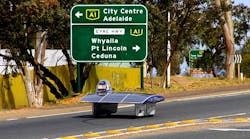I recently returned from a wonderful vacation in the Land Down Under where, on one of many excursions that brought me face to face with one of the coolest countries I’ve ever visited, I ran into a group of young engineering students from Belgium who were on holiday.
These young men and women had just finished competing in an international solar vehicle race that sent them chasing across the Australian outback some 3,000 kilometers in solar-powered cars that they designed and built. They were excited about the culmination of more than a year’s worth of research and construction of vehicles powered only by solar arrays and built for speed. They were solar engineering junkies.
So I asked what came next. Many had no idea. We talked about career paths and interestingly, many of these kids were very focused on alternative energy, but none had a clue as to how they could apply that in real life. Somehow our conversation turned to the smart grid, which is something that is near and dear to this old American. Surprisingly, though, it was something that many of these folks had heard of, they didn’t understand the role they could play in it.
That got me thinking: As the plan to implement a thorough upgrading of the national power grid in the U.S. (and around the world, for that matter) moves further along, doesn’t that create an opportunity for college graduates in general and our industry in particular, with regard to job creation and careers?
It seems to me that this is something that fits in nicely with the morals of today’s youth as well as the need to become more efficient in how we consume electricity.
This past fall, the U.S. Bureau of Labor Statistics (BLS) released a report, written by an economist named James Hamilton, titled “Powering the Nation: Smart Grid Careers.” In it, he states that, “Implementing the smart grid requires many workers in various occupations. And after the smart grid is set up, other workers will be needed to operate and maintain it.
“Work related to the smart grid is expected to result in about 280,000 new positions.
“These jobs span several occupational groups and include engineers, technicians, and construction workers. In addition to employment with utilities, many workers will be hired by suppliers and contractors.”
The report goes on to highlight the occupations that would be most useful in designing, building, and maintaining the grid and includes computer, mathematical, architecture, and engineering occupations, installation, maintenance, and repair occupations, and more. In all cases, it focuses only on the electrical engineering and contracting careers. It DOES NOT include mechanical engineers in its lists.
Why not?
Mechanical systems and lighting make up a building’s largest appetite for electricity and it is our industry that designs, builds, and maintains these systems. And it’s the facilities engineers who monitor and analyze a building’s use and can then tweak those systems to work more efficiently.
It really doesn’t matter to me that the BLS doesn’t document this in its report, but it should matter to the HVAC industry. There are engineering students, like those I met from Belgium, who are looking for a place to apply their education and knowledge and I think the HVAC industry—along with the smart grid —are brilliant choices.
I suggested as much to my new, young friends and they were interested in learning more. Shouldn’t we do this as an industry?









